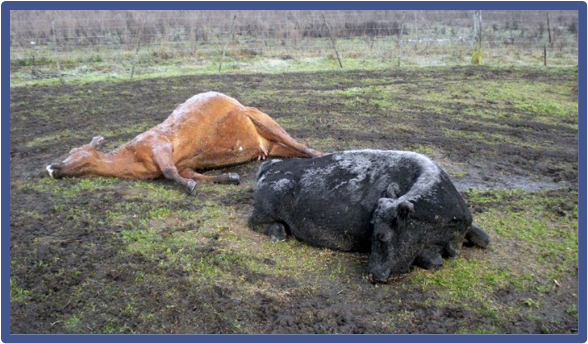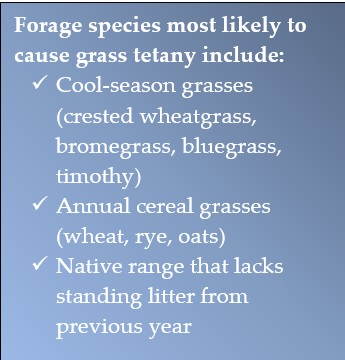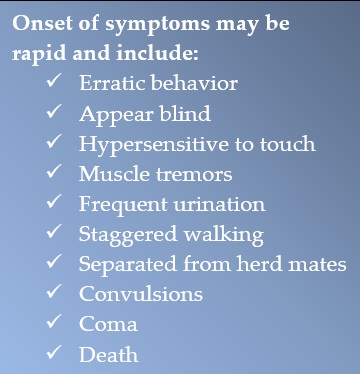Grass tetany, also called grass staggers, wheat pasture poisoning, or hypomagnesemia, is caused by low blood magnesium. It is most common in late gestation or heavy lactation cows and ewes grazing lush spring pastures. Occasionally, cases present in fall as well. Forages growing rapidly tend to have low levels of magnesium. This is compounded by that magnesium also being less available due to high protein and potassium concentrations within the forage. Cows grazing grass-heavy pastures account for the majority of cases. Damp, cloudy, and windy weather with daytime temperatures 40 – 60 F tend to be the ideal conditions for grass tetany. Rarely is this condition seen in legume or legume/grass fed animals as they contain at least double the magnesium compared to grass.
grazing lush spring pastures. Occasionally, cases present in fall as well. Forages growing rapidly tend to have low levels of magnesium. This is compounded by that magnesium also being less available due to high protein and potassium concentrations within the forage. Cows grazing grass-heavy pastures account for the majority of cases. Damp, cloudy, and windy weather with daytime temperatures 40 – 60 F tend to be the ideal conditions for grass tetany. Rarely is this condition seen in legume or legume/grass fed animals as they contain at least double the magnesium compared to grass.
Pasture management is important in prevention of hypomagnesemia. Sufficient forage should be left on pastures in the fall to retain subsoil moisture and reduce runoff. The old growth will also provide magnesium and help to balance the mineral profile of fresh spring grass. Avoid excessive fertilizer use on pastures with nitrogen and potassium as they can reduce the available magnesium to the animal as well. Preferably, wait for grass to grow several inches tall before turning cattle out on grass pastures. Otherwise, graze less susceptible groups of cattle on potentially problematic pastures (dry cows, heifers, stocker cattle, and cows with calves 4+ months of age).
Additionally, encourage daily intake of magnesium through loose mineral, cattle cake, or lick tubs.

Prime Cuts: Grass Tetany
Famo Feeds • 446 Industrial Dr • Freeport, MN • 800-450-2145 |

